 (Porseleine)
Lampetkan
(Porseleine)
Lampetkan (Porseleine)
Lampetkan
(Porseleine)
Lampetkan17. De Lampetkan aka
De Porseleine Lampetkan - washing jug / L'aiguière (workshop active
from 1609 - 1811), Nieuwe Langendijk, south side / Oosteinde, east side. 'Names
of houses' file mentions it in 1739 as the south western corner of Nieuwe Langendijk.
Delft blue shop.
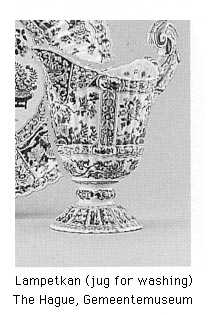
Masters & apprentices
All masters and apprentices working at this workshop had to be inscribed in the Delft St Luke Guild Book. In 1877 this book was published in a 120 page text by Obreen. In 2002 this text has been scanned and is now available and fully searcheable on this internet site. See the yellow field on top; first click the heading Delft Artists & Patrons and then click Obreen. The full text is in Dutch. Spelling varies; in order to find masters or apprentices of a faience workshop (plattielbackers, plateelbacker, platielbacker, betielbacker) search for the letters "plat".
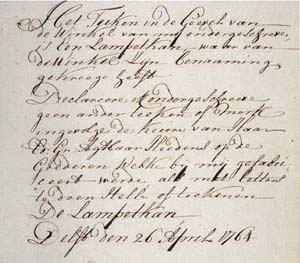
Translation from Trade Mark book 1764: "The sign in the facade of the shop of the undersigned is a Lampetkan (Jug for washing the face etc.) which is the name of the shop. I the undersigned declare that no other trade mark sign is entered on the goods which are produced here but "De Lampetkan".
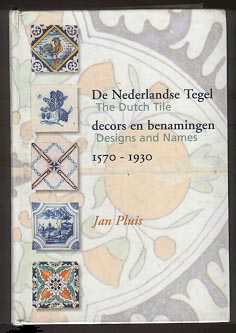 Delftware
Connoisseurship
Delftware
Connoisseurship
A serious collector of Delftware will attempt to identify and date the object. On Delft blue plates and other Delftware objects such as jugs, a potters mark may give a first indication. One should always treat potters marks with caution. Marks should be considered as just one indication.
A correct dating of Delft blue tiles is much more complicated; there is usually no potters mark on a tile. Regarding tiles the serious researcher may rely instead on one of the following sources: 1) company archives 2) the date set by actual tiles still found in situ in a building which itself can be dated, 3) the design or image ; the best documentation collection is the archive of 70.000 photos in the Nederlands Tegelmuseum in Otterlo near Arnhem, The Netherlands, 4) the size, thickness and other technical characteristics. An excellent source book with thousands of illustrations and technical discussions is this recent book in Dutch and English, written by Jan Pluis (see the cover to the right).
Only these Delft potteries produced Delft blue tiles: Rouaan, later known as Het Lage Huys; De Lampetkan, De Vergulde Blompot, De Ham, De Dissel, De Paeuw / Paauw, De Roos, De Grieksche A.
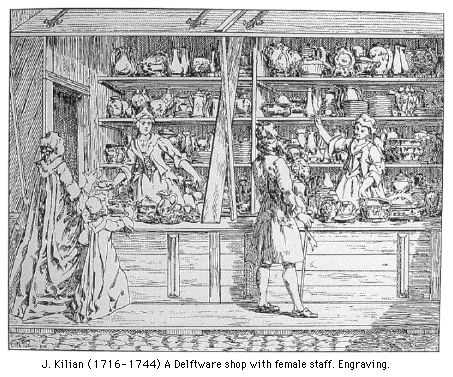
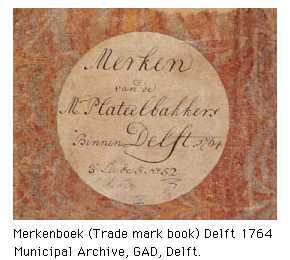 Full
presentation at http://www.xs4all.nl/~kalden
Email the author at kalden@xs4all.nl
Full
presentation at http://www.xs4all.nl/~kalden
Email the author at kalden@xs4all.nl
All questions about identifying, dating, valuing, buying and selling: please go to www.Aronson.nl.
Notes: Thanks to the Delft Archives Staff for their help and enthusiasm. A well researched two volume book on Delftware is Marion S. van Aken-Fehmers et al, Delfts Aardewerk, Geschiedenis van een nationaal product, published jointly by Waanders, Zwolle & Gemeentemuseum, Den Haag, 1999 (part 1) and 2001 (part 2).
Mark shown in Jean Justice, 'Dictionaire des marques et monogrammes de la faience de Delft', Gand/Gent 1901.
Jan Pluis, De Nederlandse Tegel, decors en benamingen 1570-1930, The Dutch Tile, Designs and Names 1570-1930, Published by: Nederlands Tegelmuseum / Vrienden van het Nederlands Tegelmuseum [Otterlo] / Primavera Pers, Leiden 1997.
How did they make Delft blue faience? text in English
Hoe maakte men Delfts blauw plateel? Tekst in het Nederlands.
Visit The Hague municipal Gemeentemuseum site on Delft Blue.
Launched January 2002. Last update 25 October 2016.